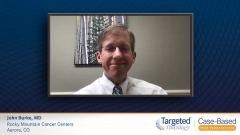
Second-line Treatment Recommendations for R/R DLBCL
John Burke, MD, considers factors for initiating second-line treatment in relapsed/refractory diffuse large B-cell lymphoma (R/R DLBCL).
John Burke, MD: What are the current guidelines for second-line therapy for patients who are not eligible for transplants, such as the patient that I have described? Just to outline the management of second-line patients who have relapsed diffuse large B-cell lymphoma [DLBCL] —the first order of business is to determine whether patients are eligible for transplant or not. That is not always completely clear from the day that you see the patient and that your perception of their transplant eligibility may change as you treat them. Maybe they have improved performance status as you go along For the most part, however, you can determine that relatively early. For patients who are eligible for transplant eligible, the standard of care remains: administer a salvage chemotherapy regimen followed by autologous stem cell transplant. That is based on old data from a trial called the PARMA study, demonstrating that autologous stem cell transplant improves overall survival when compared with just conventional chemotherapy.
Patients who are ineligible for transplants have a wider variety of options, one of which is a conventional chemotherapy regimen, such as the combination of rituximab, gemcitabine, and a platinum agent. In more modern times, we now have a couple of newer regimens that are available for patients like that, one of which is the combination of polatuzumab, bendamustine, and rituximab. This was initially FDA approved as a third-line therapy, but NCCN [National Comprehensive Cancer Network] guidelines have now incorporated it as an option for patients as second-line therapy. Indeed, patients in the second line were studied in the clinical trial and demonstrated clinical benefit with that regimen. A third option for patients who are ineligible for transplant is tafasitamab and lenalidomide, and this is an option for second-line therapy and beyond. For third-line therapy, the preferred approach for most patients is CAR [chimeric antigen receptor] T-cell therapy. There are now three CAR T-cell products on the market that are approved for patients with experience with at least 2 prior regimens. Patients who are not eligible for CAR T-cell therapy can be treated with any of the options listed previously, such as pola-benda-rituximab [polatuzumab vedotin plus bendamustine and rituximab], tafasitamab and lenalidomide. Alternatively, these patients can receive a novel agent, Selinexor or they can receive conventional chemotherapy. Exactly how to sequence all those options is not known—there really is not a clear best way to sequence all those treatments.
What percentage of patients relapse or refractory to frontline treatment? About a third of patients will relapse or have primary refractory disease. The majority of these are relapses and not primary refractory. I will point out that not everyone who has a positive PET scan at the end of therapy definitely has persistent disease. There was interesting data from a trial called the REMARC trial that demonstrated that, of the patients who achieved only a partial remission by PET scan at the end of induction, only about three-quarters of those patients eventually progressed. That is, about one-quarter of those patients converted to complete responses with no additional therapy. If you have an end-of-treatment PET scan that is abnormal, you definitely want to confirm with a biopsy that that patient has persistent active lymphoma before you commit that patient to additional treatment. As I said, perhaps one-fourth of positive PET scans turn out not to truly reflect residual disease.
Transcript edited for clarity.
Case: A 76-Year-Old Man with R/R DLBCL
Initial presentation
- A 76-year-old man presented with fatigue, loss of appetite
- PMH: atrial fibrillation, hypertension, medically controlled
- PE: palpable 5 cm right inguinal mass; bilateral axillary lymphadenopathy; splenomegaly
- ECOG PS 2
Clinical Workup
- Labs: Hb 9.9 g/dL; all others WNL
- Hepatitis B, C and HIV negative
- Excisional biopsy of the lymph node confirmed DLBCL, GCB subtype
- IHC positive for CD20
- FISH panel: t(14;18) with a BCL2 rearrangement
- Flow cytometry: CD19-postitive
- Whole body PET/CT scan showed diffuse lymphadenopathy , splenomegaly
- Ann Arbor stage III DLBCL
- IPI score intermediate-risk
Treatment
- Treated with R-CHOP x 6 cycles
- First post-treatment PET/CT scan was unremarkable; CR
- 1 year later he presents with recurrent axillary lymphadenopathy
- Repeat biopsy confirms relapse of DLBCL, GCB subtype
- He was ineligible for high-dose chemotherapy and ASCT
- Initiated tafasitamab + lenalidomide







































